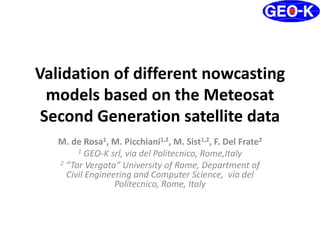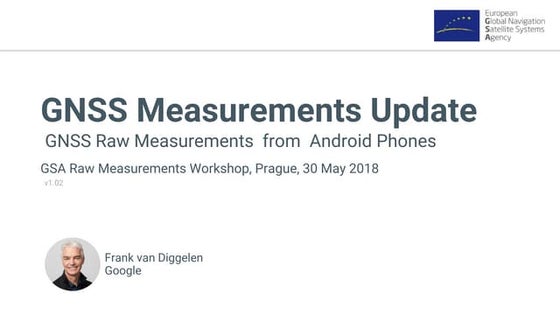Validation of different nowcasting models based on the Meteosat Second Generation satellite data
- 1. Validation of different nowcasting models based on the Meteosat Second Generation satellite data M. de Rosa1, M. Picchiani1,2, M. Sist1,2, F. Del Frate2 1 GEO-K srl, via del Politecnico, Rome,Italy 2 ŌĆ£Tor VergataŌĆØ University of Rome, Department of Civil Engineering and Computer Science, via del Politecnico, Rome, Italy
- 2. Outline ŌĆó Nowcasting ŌĆó The StormTrack model ŌĆó The validation ŌĆó The benchmark ŌĆó Validation at South Africa (case studies) ŌĆó Validation at Europe (Summer 2015) ŌĆó Summary ŌĆó Future tasks 2015-09-23 Eumetsat Conference 2015 - Toulouse
- 3. Nowcasting ŌĆó Very short term weather prediction (within few hours) over a certain area ŌĆó Prediction of extreme weather events like thunderstorms, floods, hurricanes, tornadoes ŌĆó Near real time computation time: in parallel with observations (weather stations, soundings, satellite images, weather radar) ŌĆó Very useful to the outdoor activities, air traffic control, agrometeorology 2015-09-23 Eumetsat Conference 2015 - Toulouse
- 4. The actors StormTrack The benchmark The ground truth The validation tool 2015-09-23 Eumetsat Conference 2015 - Toulouse
- 5. The StormTrack model ŌĆó MSG as unique data source ŌĆó (Early) Detection of the convective objects ŌĆó Tracking of the detected objects ŌĆó Cells lifecycle monitoring ŌĆó Temporal and spatial extrapolation of the detected objects ŌĆó High computation efficiency and reliability ŌĆó Easy to use 2015-09-23 Eumetsat Conference 2015 - Toulouse
- 6. The StormTrack model ŌĆó Cell Detector (CDT) ŌĆó Cell Tracker (CTK) ŌĆó MSG Nowcasting Engine (MNE) ŌĆó CTWriter 2015-09-23 Eumetsat Conference 2015 - Toulouse STK
- 7. The StormTrack model JSON Public APIs 2015-09-23 Eumetsat Conference 2015 - Toulouse
- 8. The algorithm: CDT 2015-09-23 Eumetsat Conference 2015 - Toulouse ŌĆó Use the 5,6 and 9 channels ŌĆó BTD6,9 cloud base detection (early detection) ŌĆó BTD5,9: cloud top detection (Kolios and Feidas, 2010) ŌĆó Connected components ŌĆó Convex approximation ŌĆó Object definition (properties)
- 9. The Validation ŌĆó MET is a set of verification tools developed by the Developmental Testbed Center (DTC) for use by the numerical weather prediction community to help them assess and evaluate the performance of numerical weather predictions. ŌĆó The primary goal of MET development is to provide a state-of-the- art verification package to the NWP community. By ŌĆ£state-of-the- artŌĆØ it means that MET will incorporate newly developed and advanced verification methodologies, including new methods for diagnostic and spatial verification and new techniques provided by the verification and modeling communities. ŌĆó Several tools are part of the MET package and the MODE (object oriented validation) tool has been chosen for the validation of the StormTrack algorithm. DonŌĆÖt reinvent the wheel Write new routines? New validation techniques? 2015-09-23 Eumetsat Conference 2015 - Toulouse
- 10. The Validation 0 0.1 0.2 0.3 0.4 0.5 0.6 0.7 0.8 0.9 1 POD FAR 2015-09-23 Eumetsat Conference 2015 - Toulouse
- 11. The benchmark ŌĆó RDT, Rapid Development Thunderstorms, has been (and is) developed by Meteo-France in the framework of the EUMETSAT SAF in support to Nowcasting. ŌĆó Using mainly geostationary satellite data, it provides information on clouds related to significant convective systems, from meso-alpha scale (200 to 2000 km) down to smaller scales (few pixels). ŌĆó The RDT algorithm includes three steps: ŌĆō The detection of cloud systems ŌĆō The tracking of cloud systems ŌĆō The discrimination of convective cloud objects ŌĆó Only objects flagged as convective have been taken into account RDT: the state-of-the-art in storms detection 2015-09-23 Eumetsat Conference 2015 - Toulouse
- 12. Validation at South Africa ŌĆó 6 case studies during summer 2014 (12 UTC ŌĆō 18 UTC) ŌĆó Lightning network: accuracy 500m, CG strikes, 19 detectors ŌĆó Strikes 5 mins before/after MSG slot time ŌĆó RDT setup: MSG HRIT, NWP, lightning data (thanks to SAWS) ŌĆó StormTrack setup: MSG HRIT 2015-09-23 Eumetsat Conference 2015 - Toulouse
- 13. South Africa case study: 2014/12/16 2015-09-23 Eumetsat Conference 2015 - Toulouse
- 14. Event statistics 0.00 0.50 1.00 1.50 2.00 2.50 3.00 3.50 4.00 4.50 0 50 100 150 200 250 300 350 400 Strikes Density (strikes/px) 2015-09-23 Eumetsat Conference 2015 - Toulouse Strikes Density
- 15. StormTrack vs RDT PODs 0 0.1 0.2 0.3 0.4 0.5 0.6 0.7 0.8 0.9 1 POD STK POD RDT 0.00 0.50 1.00 1.50 2.00 2.50 3.00 3.50 4.00 4.50 0 50 100 150 200 250 300 350 400 Strikes Density (strikes/px) Higher lightning activity 2015-09-23 Eumetsat Conference 2015 - Toulouse
- 16. StormTrack vs RDT FARs 0 0.1 0.2 0.3 0.4 0.5 0.6 0.7 0.8 0.9 1 FAR STK FAR RDT 0.00 1.00 2.00 3.00 4.00 5.00 0 50 100 150 200 250 300 350 400 Strikes Density (strikes/px) Higher lightning activity 2015-09-23 Eumetsat Conference 2015 - Toulouse
- 17. South Africa case study: 2014/12/08 2015-09-23 Eumetsat Conference 2015 - Toulouse
- 18. Event statistics 0.00 2.00 4.00 6.00 8.00 10.00 12.00 14.00 16.00 18.00 0 500 1000 1500 2000 2500 Strikes Density (strikes/px) 2015-09-23 Eumetsat Conference 2015 - Toulouse Strikes Density
- 19. StormTrack vs RDT PODs 0 0.1 0.2 0.3 0.4 0.5 0.6 0.7 0.8 0.9 1 POD STK POD RDT 2015-09-23 Eumetsat Conference 2015 - Toulouse
- 20. StormTrack vs RDT FARs 0.00 2.00 4.00 6.00 8.00 10.00 12.00 14.00 16.00 18.00 0 500 1000 1500 2000 2500 Strikes Density (strikes/px) 0 0.1 0.2 0.3 0.4 0.5 0.6 0.7 0.8 0.9 1 FAR STK FAR RDT 2015-09-23 Eumetsat Conference 2015 - Toulouse
- 21. South Africa case study: 2014/11/10 2015-09-23 Eumetsat Conference 2015 - Toulouse
- 22. Event statistics 0.00 2.00 4.00 6.00 8.00 10.00 12.00 14.00 16.00 0 500 1000 1500 2000 2500 3000 3500 Strikes Density (strikes/px) 2015-09-23 Eumetsat Conference 2015 - Toulouse Density Strikes
- 23. StormTrack vs RDT PODs 0 0.1 0.2 0.3 0.4 0.5 0.6 0.7 0.8 0.9 1 POD STK POD RDT 0.00 2.00 4.00 6.00 8.00 10.00 12.00 14.00 16.00 0 500 1000 1500 2000 2500 3000 3500 Strikes Density (strikes/px) 2015-09-23 Eumetsat Conference 2015 - Toulouse
- 24. StormTrack vs RDT FARs 0 0.1 0.2 0.3 0.4 0.5 0.6 0.7 0.8 FAR STK FAR RDT 0.00 2.00 4.00 6.00 8.00 10.00 12.00 14.00 16.00 0 500 1000 1500 2000 2500 3000 3500 Strikes Density (strikes/px) 2015-09-23 Eumetsat Conference 2015 - Toulouse
- 25. Summary: South Africa case studies 0 0.1 0.2 0.3 0.4 0.5 0.6 0.7 0.8 0.9 1 12,00 13,00 14,00 15,00 16,00 17,00 Hours UTC StormTrack vs RDT Mean StormTrack POD Mean RDT POD Mean StormTrack FAR Mean RDT FAR Lower StormTrack FAR (0.2 vs 0.3) Higher RDT POD in the morning Higher StormTrack POD in the afternoon 2015-09-23 Eumetsat Conference 2015 - Toulouse
- 26. Validation at South Africa: Summarising ŌĆó Mean StormTrack Accuracy (POD): 0.5 ŌĆō 0.41 in the morning ŌĆō 0.61 in the afternoon ŌĆó Mean RDT Accuracy (POD): 0.54 ŌĆō 0.58 in the morning ŌĆō 0.51 in the afternoon ŌĆó Mean StormTrack FAR: 0.2 ŌĆō 0.2 in the morning ŌĆō O.2 in the afternoon ŌĆó Mean RDT FAR: 0.32 ŌĆō 0.27 in the morning ŌĆō 0.38 in the afternoon 2015-09-23 Eumetsat Conference 2015 - Toulouse
- 27. Validation at Europe ŌĆó Mid June 2015 ŌĆō Mid Sep 2015 (00 UTC-21 UTC) ŌĆó ATDNet lightning data (sampled every 5 mins) ŌĆó Strikes 5 mins before, 10 mins after MSG slot time ŌĆó RDT setup: MSG HRIT, NWP, lightning data (thanks to AEMET) ŌĆó StormTrack setup: MSG HRIT 2015-09-23 Eumetsat Conference 2015 - Toulouse
- 28. Validation at Europe 2015-09-23 Eumetsat Conference 2015 - Toulouse Credits Jocken Kerkmann (EUMETSAT)
- 29. ŌĆó Over 5000 samples collected (Mid June 2015 ŌĆō Mid Sept 2015) for StormTrack ŌĆó Over 3000 samples collected (Mid June 2015 ŌĆō Mid Aug 2015) for RDT ŌĆó No filters on ground data: investigating about the model(s) sensitivity Validation at Europe 2015-09-23 Eumetsat Conference 2015 - Toulouse Density Strikes Density Strikes Density Strikes Density Strikes
- 30. Validation at Europe: Scores vs Strikes StormTrack RDT Discriminant: 250 strikes, POD>FAR Discriminant: 130 strikes 2015-09-23 Eumetsat Conference 2015 - Toulouse
- 31. Validation at Europe: Scores vs Matched objects area StormTrack RDT Discriminant:750 pixels Discriminant: 360 pixels 2015-09-23 Eumetsat Conference 2015 - Toulouse
- 32. Validation at Europe: Scores vs Strikes density StormTrack RDT Discriminant: 3.5 strikes/px Discriminant: 1.9 strikes/px2015-09-23 Eumetsat Conference 2015 - Toulouse
- 33. Validation at Europe: Hourly Scores RDT Higher STK POD Lower STK FAR2015-09-23 Eumetsat Conference 2015 - Toulouse
- 34. Validation at Europe: Summarising ŌĆó Mean StormTrack Accuracy (POD): 0.6 ŌĆó Mean RDT Accuracy (POD): 0.7 ŌĆó Mean StormTrack FAR: 0.54 ŌĆó Mean RDT FAR: 0.49 ŌĆó Sensitivity: ŌĆō Strikes: STK 250, RDT 130 ŌĆō Matched area: STK 750, RDT 360 (px) ŌĆō Strikes density: STK 3.5, RDT 1.9 (strikes/px) 2015-09-23 Eumetsat Conference 2015 - Toulouse STK suitable on extreme events RDT suitable on different conditions
- 35. Our nowcasting equipment DISH: 110 cm LNB Inverto Reception station: 8 GB Ram Quad core 3 GHz TBS 6983 DVB S2 card Win 7 BDADataEx DVBS2 card sw STK HW:I7 Quad core 3.2 GHz 8 GB FD Processing time: 7 mins Linux CentOS 6.0 2015-09-23 Eumetsat Conference 2015 - Toulouse
- 36. Summary ŌĆó Validation over South Africa (6 case studies) and Europe (Summer 2015) ŌĆó MET framework for validation (Object Oriented using MODE tool) ŌĆó StormTrack setup: MSG HRIT ŌĆó RDT (benchmark) setup: MSG HRIT, NWP, lightning data ŌĆó Good results in the afternoon on South Africa case studies ŌĆó Over Europe better RDT POD but comparable FAR. BTW good STK POD on average (no ground data or NWP) ŌĆó STK flexible and ŌĆ£lightŌĆØ (less than 2 GB RAM needed on FD) ŌĆó Issues on cold base clouds 2015-09-23 Eumetsat Conference 2015 - Toulouse
- 37. Future tasks ŌĆó Validation over Europe will go on (divide the region into sub regions) ŌĆó Automatic trajectories extrapolation ready but not yet operational (15/30 mins ahead) ŌĆó RSS integration ŌĆó Neural nets to improve POD/reduce FAR (pruning using other MSG channels) ŌĆó Public APIs development to share data (first version online) ŌĆó App and IoT (Internet of Things) integration 2015-09-23 Eumetsat Conference 2015 - Toulouse
- 38. Acknowledgements ŌĆó Estelle de Coning (SAWS) and SAWS for the RDT and the lightning data ŌĆó Cecilia Marcos (AEMET), Ana S├Īnchez Piqu├® (AEMET) and AEMET for the hints about MET, the RDT and the lightning data ŌĆó Italian Air force Meteorological Office for the support 2015-09-23 Eumetsat Conference 2015 - Toulouse
- 39. Thanks for your attention michele.derosa@geo-k.it Questions?






















































































